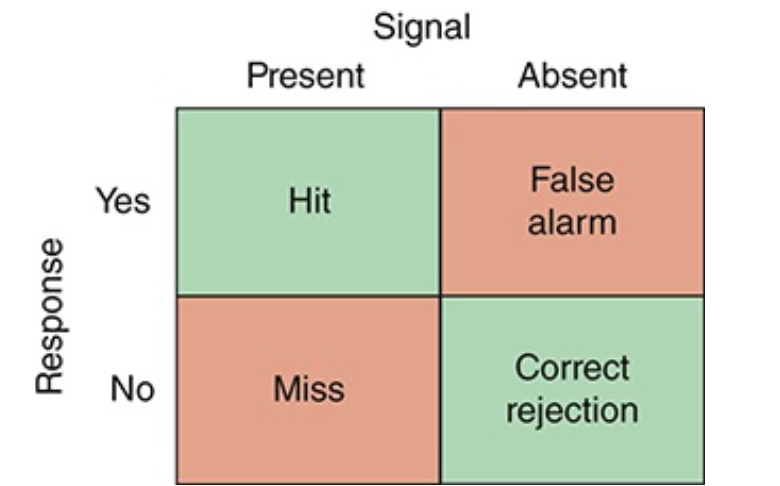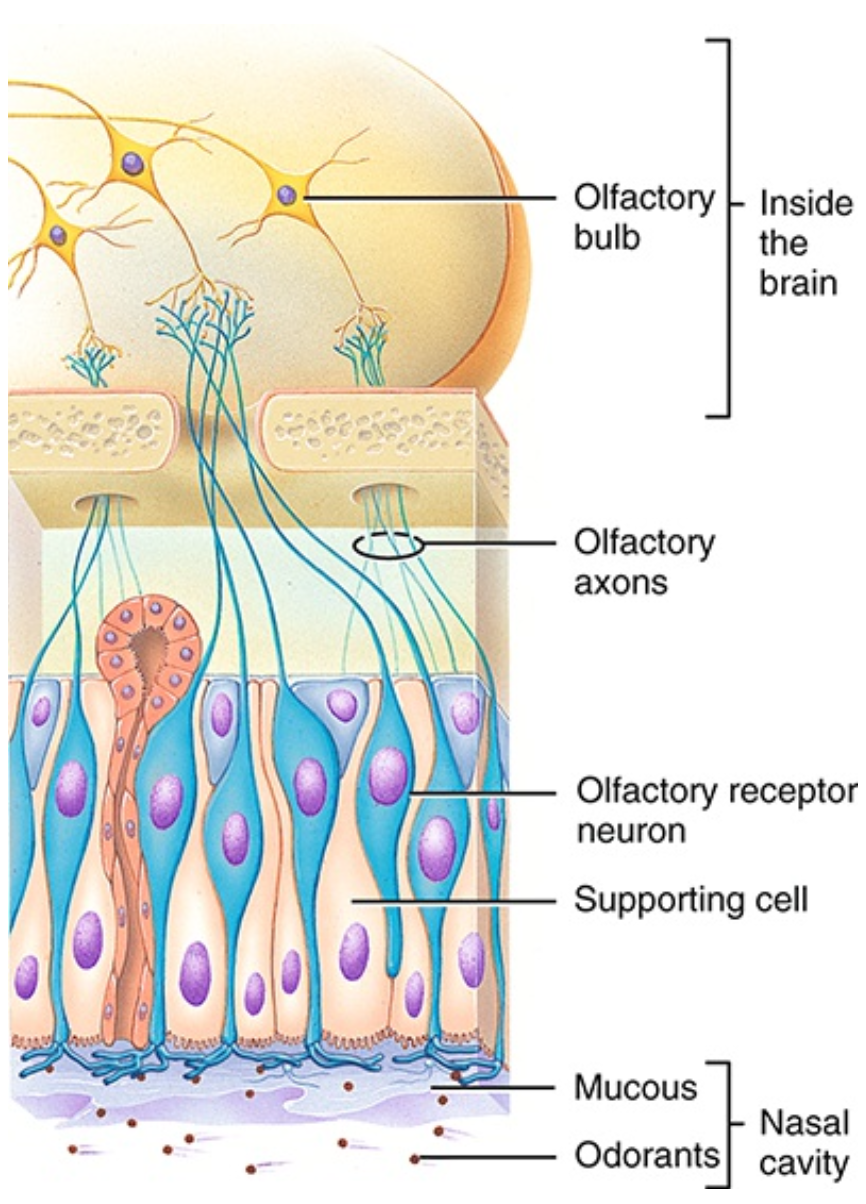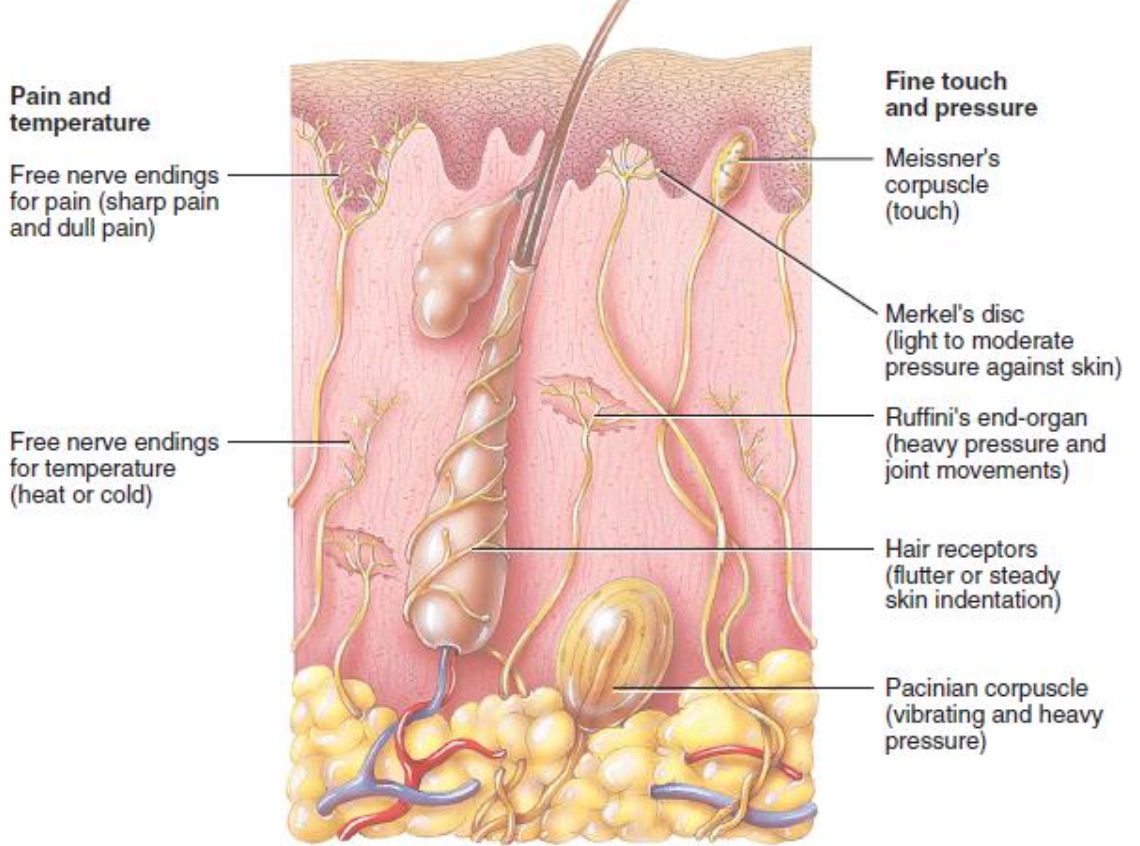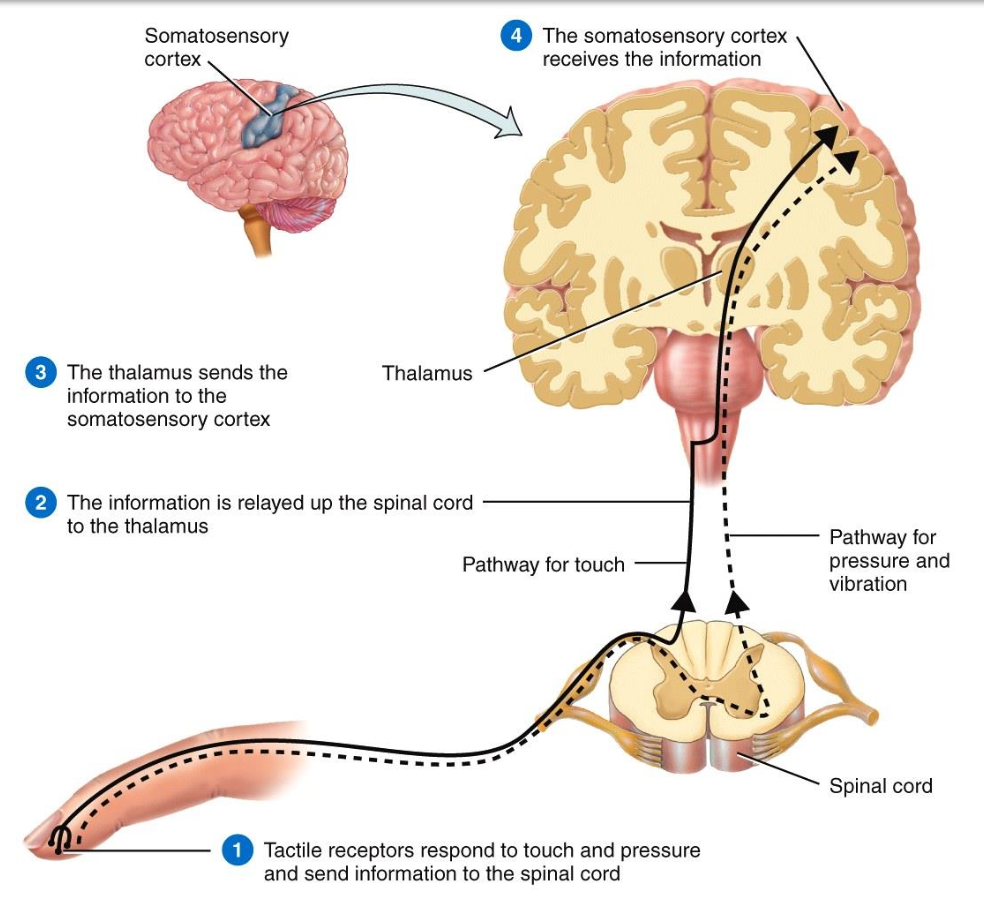Chapter 5 pt1
1/47
There's no tags or description
Looks like no tags are added yet.
Name | Mastery | Learn | Test | Matching | Spaced |
|---|
No study sessions yet.
48 Terms
Sensation vs Perception
Sensation: the act of using out sensory systems to detect environmental stimuli
what stimuli does our body detect
Perception: the conscious recognition and identification of a sensory stimulus
How does our brain make sense of the information our sense have detected
Types of sensory systems and their physical stimuli
Olfactory (smell) - Odourants
Somatosensory (touch) - Pressure or damage to skin
Gustatory (taste) - Chemicals
Auditory (hearing) - Sound waves
Visual (sight) - Light (photons)
What are sensory receptor cells
Specialized cells that convert a specific form of environmental stimuli into neural impulses (sensory transduction)
What is sensory transduction
Process of converting a specific form of environmental stimuli into a neural impulse that our brain can read
What is Absolute threshold
Smallest amount of stimulus that one can detect
Smell - drop of perfume
Taste - 5ml of sugar in 9L of water
Touch - an insect wing falling on your cheek from 1cm
Hearing - tick of a watch at 6m away
Sight - candle flame 50 km away in a dark room
What is the difference thresholds
The minimal difference needed to notice a difference between 2 stimuli
Sensory sensitivity depends on experience, expectations and consequences for failure
someone who notices a faint smell has a high sensory sensitivity
If you listen to music on your iphone, how much do you have to turn up the volume before you notice the music getting louder
What is signal detection theory
response to a signal in every situation depends on an individual’s ability to differentiate between the signal and noise, and on their response criteria
What is sensory adaptation
Repeated stimulation of a sensory cell leads to a reduced
response
E.g. The tag in your shirt that bothered you in the morning but you don’t feel anymore
E.g. Olfactory adaptation - when you walk into a coffee shop and you slowly stop smelling the coffee

What is bottom-up processing
Perception that proceeds by transducing environmental stimuli into neural impulses that move successively into more complex brain regions
What is top-down processing
Perception processes led by cognitive processes, such as memory or expectations
What is perceptual sets
Example of Top-down processing
Readiness to interpret a certain stimulus in a certain way
usually occur when faced with ambiguous stimuli (multiple interpretations)
Processing sensory information
Bottom-up Processing
Physical stimuli from the environment → neural impulses sent to CNS → perception
Top-down Processing
Previously acquired knowledge → perception
Perception typically involves both types of processing
e.g. recognizing objects/songs/faces
What are the 5 main senses
Smell, taste, touch, sound and sight
BUT there’s
Kinesthetic (body’s movement, posture)
Vestibular (head’s position and movement)
What are the two senses “touch” can be separated into
Separated into thermoception (temperature detection) and nociception (pain detection
What sensory receptors are designed to detect chemicals
Olfactory sense (smell) and Gustatory sense (taste)
What is the pathway of chemical sense (smell)
Odourants: airborne chemicals bind to receptors that are detected as odours
Olfactory receptor neurons: sensory receptor cells that convert chemical signals from odourants into neural impulses that travel to the brain
Reach the amygdala and hippocampus
Continuous exposure to a specific smell will result in fatigue of olfactory receptor neurons
What is the pathway of chemical sense (taste)
Papillae - bumps on the tongue that contain clumps of taste buds
Taste buds - clusters of sensory receptor cells that convert chemical signals from food into neural impulses that travel to the brain
Taste is actually called flavour (combination of small and taste)
What are the five taste receptors on your tongue
Taste receptors have cilia that contain actual receptors
Sweet
Sour
Bitter
Salt
Umami - taste of MSG
What other sense is activated when you eat
Tactile sense
The consistency of a particular food is not relayed to the brain via the taste receptors but rather by inputs from touch receptors located on the tongue
How do we experience spice
The sensation we experience when eating spicy food is related to tactile systems that communicate information about pain
Capsaicin (spicy chemical) activates pain receptors located in the tongue
Some people enjoy it and some people dont
What makes sensory receptors of taste different
When you eat hot (temperature) food it burns you mouth and damages the taste receptors
These receptors are able to regenerate
When is smell and taste developed
Smell is developed at birth
Newborns show preference for the odour of their mother’s milk
Taste is also developed at birth (preference towards sweet)
Taste buds are not evenly distributed across the tongue (most are the top of the tongue)
Around age 7 children start to like sour tastes (e.g. sour patches)
Why are kids typically more picky
Due to the higher number of taste buds
The taste of certain foods may seem too strong because of the large amount of taste buds produce more neural impulses than adults would
How does the brain process smell and taste
Signal from olfactory receptor neurons travel to the brain via olfactory nerve
Info is carried along olfactory nerves → olfactory bulb (located base of the front brain beneath the frontal lobes) → olfactory information is sent to regions of cerebral cortex (piriform cortex)

What is an olfactory bulb
The first region where olfactory information reaches the brain on its way from the nose
Sends information to the amygdala (emotions & fear) and indirectly to the hippocampus (learning & memory)
Smells evoke memories
What is the piriform cortex responsible for
Primary area for processing smell
This cortex is plastic (changeable in adulthood)
Do taste receptors have axons?
No, the connect with sensory neurons on the tongue to send information to our brains
Sent to the thalamus and cerebral cortex
What is the insula
Part of the cortex that receives taste information
Associated with emotion of disgust
Activates with bad smell, taste and repulsive visual images
What are some smell and Taste disorders
Ageusia - inability to taste (rare)
Anosmia - inability to detect odours
Hyposmia - reduced ability to smell
Reflex epilepsy - seizure occurs only after exposure to a specific odour
Migraine headaches - specific odours trigger migraines
Disorders may implicate dysfunction in the brain, sensory receptors, or both
What is the tactile or somatosensory system composed of
Combination of skin senses
Pressure
Touch
Temperature
Vibration
Pain
The tactile senses rely on variety of receptors located in different parts of the skin
Different somatosensory receptors
Free nerve endings
Located near the surface of the skin
Detect touch, pressure, pain and temperature
Meissner’s corpuscles
located in the fingertips, lips and palms
Transduce information about sensitive touch
Merkel’s discs
located near the surface of the skin
transduce information about light to moderate pressure against the skin
Ruffini’s end-organs
located deep in the skin
register heavy pressure and movement of the joints
Pacinian corpuscles
located deep in the skin
respond to vibrations and heavy pressure

What are the steps to perceiving touch
Tactile receptors respond to touch and pressure and send information to the spinal cord
Information is relayed up to the spinal cord to the thalamus
The thalamus sends the information to the somatosensory cortex
The somatosensory cortex receives the information
Our brain processes tactile information contralaterally (opposite side of the brain from the body where touch occurred)

What are the two pathways of pain
Fast pathway (myelinated): sharp, localized pain is felt quicker because it travels along myelinated neurons to the brain
Slow pathway (unmyelinated): inputs communicate with brain regions involved in processing emotions; pain we perceive via the slow pathway is more often burning pain than sharp pain
How are tactile senses developed
Developed at birth
After birth the ability to respond to somatosensory stimuli is dependent on brain development and learning
Physical contact is required for healthy development in infancy (Harry Harlow)
What is an example of activation of somatosensory pathway?
Tickling, usually an enjoyable somatosensory input
Causes an uneven, uncontrollable, and unexpected manner
What are the three different tactile sense disorders
Chronic pain - common
No pain (familial dysautonomia) - rare genetic condition associated with an inability to detect pain or temperature & produce tears
Phantom limb sensations - tactile hallucinations of touch, pressure, vibration, and pain in the body part that no longer exists
How does the body reduce pain, and how do pain-relief drugs work?
The body uses endorphins and enkephalins to block pain naturally.
Opiate drugs like morphine and oxycodone copy these chemicals to relieve pain.
Touch (like rubbing a sore area) can also reduce pain using the gate control theory.
What is the gate control theory of pain
Theory that certain patterns of neural activity can close a “gate” to keep pain information from travelling to parts of the brain where it is perceived
What are sound waves, and how do frequency and amplitude affect what we hear?
Sound waves - vibrations of the air in the frequency of hearing
Frequency - the number of cycles per second in a wave
Determines pitch of sound
Measured in units called Hertz which represent cycles per second
We hear best in the range of 2000-5000Hz
Amplitude - magnitude (height of a wave)
determines loudness
Measured in units called decibels
How does the ear hear
Sound wave enter ears and deflect tympanic membrane
Waves pass into the middle ear, which contains the three smallest bones in the human body the ossciles (composed of maleus, incus, and stapes)
Stapes hits the oval window, causing a wave to form in the fluid in the cochlea
The fluid deflects the basilar membrane, bending its hair cells that transduce the fluid sound wave into electrical activity
As hair cells move, neural impulses are created and sent to the brain
Signal travels to the brainstem, thalamus, and auditory cortex
In the auditory cortex, sound is received in a tonotopic map
Certain frequencies are always received by specific areas of auditory cortex
How do you identify frequency and pitch
Frequency theory
different sound frequencies are converted into different rates of action potentials
High-frequency sounds produce a more rapid firing than do low-frequency sounds
Place theory
Differences in sound frequency activates different regions of the basilar membrane
The brain equates the place activity occurred on the basilar membrane with a particular frequency
What is absolute pitch
Ability to recognize any notes on a musical scale
Develops between 3 and 6 years of age
People who speak tonal languages are more likely to have absolute pitch
How does sound adaptation occur
Muscles around our ears can contract so less of the sound wave enters the ear
Our ears become less sensitive to continuous noises
Our brains filter out sounds that are not important
What is the cocktail party effect
The brain picks up on relevant sounds, even in a noisy environment
Ear ringing could be a sign of irreversible damage
How do we localize sounds
General loudness - louder sounds seem closer
Loudness in each ear - the ear closer to the sound hears a louder noise than the ear farther from the sound
Timing - sound waves will reach the ear closer to the source of the sound before they reach the ear farther away
How does hearing develop
Babies can hear before they are born
Ability to recognize and respond appropriately to sounds develops in the first few months after birth
Infants prefer speech (especially mom’s) to non-speech
What are the two types of hearing loss
Deafness - Loss of hearing (partial or complete)
Can be genetic, cause by infection, physical trauma (headphone use), exposure to toxins, high doses of common medications (aspirin)
Tinnitus - ringing in the ear
Due to abnormalities in the ear
1 in 200 experiences tinnitus
What devices aid with hearing loss
Medical devices that are implanted in the ear and are wired to the nerves that send sounds information to the brain
e.g. cochlear implants